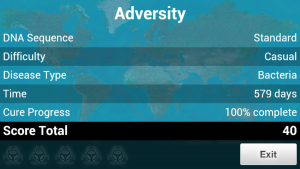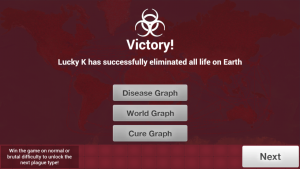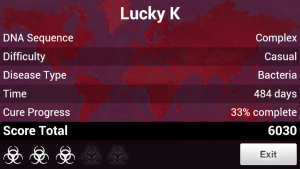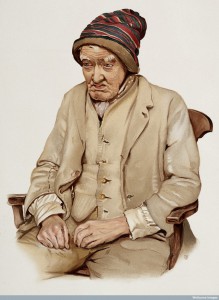The name of my disease for my first plague was called Adversity created on October 19, 2015. I started my plague in Central Africa. As soon as I started accumulating DNA points I started with water transmission and later insect transmission. I went with heat resistance and started with the symptoms of insomnia and anemia. By 12/9/15 I had already infected 103 people. By the time I could see the infection spreading and reading the news scroll on top of the screen I lost track of the 1,000,000 count and by 2/3/16 I had already infected 19,847,713 people. On 3/30/16 Central Africa started to work on a cure – that’s when I started getting worried. In May 2016, Turkey, New Guinea, and India, among others, started working on their cure research. I evolved my plague by activating the air transmission and drug resistance ability. By 11/6/16, Russia, China, and the U.S.A. were infected while cure research reached 25%. On 12/2/16, the first death occurred in Afghanistan and at the same time about 5 people were infected in Greenland at this point. I think my first death took awhile, roughly a little over a year because I waited longer to evolve the more lethal symptoms of my plague. On 12/10/16 a friendly notice of a global research was underway in developing a cure for Adversity. On 2/13/17 there were no more healthy people in the world. On 3/1/17, cure development reached 75% and this was when I think I used all my DNA points to reach the second levels of transmissions, symptoms and abilities. 26 days later 92% of the cure was complete. On 4/11/17 the cure came to a 100% completion and finally on 5/9/17 Adversity was eradicated in 579 days and the human race was saved. 
The name of my second plague was called Lucky K created on October 19, 2015. After being eradicated by plague number one, I raised the ante for Lucky K. Lucky K began in Australia. It infected 103 people by 12/3/15. From what I noticed, both my plagues have a relatively slow start. With Lucky K I noticed I did not see a lot of red areas infected and it also took awhile for it to spread. I started with the typical water transmission and started with the rash and sweating symptoms, which in my opinion paves the way for easier infection since Australia is a hot climate. By 2/26/16 my plague spread to China, Argentina and South Africa and on 3/3/16 I reached the 1,000,000 mark of infecting the world. By 4/7/16 I started seeing more red-targeted places. On 6/9/16, Australia started to work on a cure. By 7/18/16, the first recorded death was in India. However by 9/10/16, only 10 people were infected in Greenland. By 10/6/16 there was 25% cure development. By this time, I already upgraded as much as I could. By this point, the map was all infected, and on 12/7/16 no healthy person was left in the world. I just kept on waiting for what was to come afterwards and I only had 5 DNA points remaining. On 1/16/17 my plague, Lucky K, destroyed the human race despite having a 33% cure in the works. Then a glimmer of “hope” occurred on 2/12/17 stating that my Lucky K plague had mutated and the scientists introduced synthetic genes in hopes of finding a cure. However, after this date Lucky K was victorious and killed the human race in 484 days, including Greenland. 

As the creator of Adversity, I was somewhat saddened my plague did not entirely eradicate the human race. Since Adversity started in a poor nation I thought it would actually be more infectious and lethal than Lucky K. I also found it a bit odd that although my infestation with Lucky K did not start out rapidly, I figured it would be like Adversity. Considering that starting at any wealthy nation, there was a bit of a lag in spreading and I thought they might be more able to find a cure. Playing this game made me realize how fast a plague can be transmitted in just a matter of days. Even if there was a cure to be found, a lot of people may already be infected or have already died. We need to take care of ourselves and be ready and mindful of our surroundings just in case a plague does happen because this is seriously devastating and frightening.




